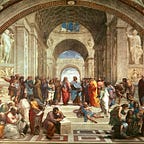Poetry for Teens?
Poetry is an art that is somewhat lost in this age. It seems reserved to english classes, and to cliche Instagram posts. Poetry requires an act of presence and beholding, it cannot be consumed quickly, but digested over time of contemplation. Myself being a young adult, I struggle to sit with poetry. When I do take the time to read, I am brought deep into the Words that are read, and deeper still when the words are spoken. The question begs, with so much Christian Poetry, how can we enliven catechesis to teens, with such a medium so foreign to them.
Thinking of recent Youth Group meetings I have planned, my mind fixes on the week before Easter. We discussed the beauty of the Paschal Triduum, but after the talk and small group, we left the teens to silent adoration to reflect upon the beauty we had discussed. While Eucharistic Adoration is a beautiful prayerful practice for the teens it is a common one that we engage with. I am inclined now to question how we could have offered a more fruitful practice for the teens to have engaged with that would have allowed them to enter deeper into an active engagement with the Material.
After teaching the teens about the Paschal Triduum, I believe that there would be great fruit from a reading of the passage Easter from The Temple by George Herbert. I believe that the poem should be recited aloud to the teens as the spoken word evokes a sense of the words becoming reality to us as discussed by Karl Rahner in Priest and Poet (4/299). After entering into a period of silence, the poem is spoken aloud slowly by a youth leader. A period of silence follows the reading and a new youth leader recites the passage a subsequent two times. The goal is to have the teens enter into a sort of Lectio on the Poem. A certain guided meditation during the silence could be quite beneficial to the teens who maybe are not formed well to understand much of the passage. Guiding them to understand the first 4 lines as a sort of outline of easter praise, the following 8 lines representing a mourning sensation, and a description of Sacrifice. The following 6 lines are introduced as an understanding of our imperfections and God’s place in completing us in our imperfections. I believe it would be beneficial to leave the last 12 lines up to interpretation for the teens to discover themselves. I believe that the guided meditations would help the teens to enter into learning of Easter in a deeper way, by having this picture painted in their heads of an Easter prayer. While the teens may be tuned out initially, the silence mixed with a sort of guiding and the repetitive nature of the activity, will form the teens to open their ears and their hearts to the words and help them to not merely learn of Easter, but encounter Easter and bring Easter into their minds and lives.
Another topic that I believe I could have used more creative aid in teaching to my youth group was on the Incarnation of our Lord. The incarnation of our Lord as the Word made flesh can be a bit complicated for our teens to fully understand. Looking at a poem such as the second stanza in John Donne’s La Corona called Annunciation, which looks at the Annunciation and Incarnation through the eyes of Mary I believe could help the teens to relate and encounter the Incarnation in a deeper way.
Many of my teens due to their cultural background, revere Our Lady of Guadalupe and have a special relationship with the Mother of God as a result. The reading of a poem, of words which take from the Word, in Scripture, puts us on the right foot to begin with to help the teens encounter the Word through words. As Karl Rahner describes in Poetry and the Christian, the Word “only attains the full realization of its being in the sacramental word” who is God made flesh (4/362). To help the teens understand this idea of the Word, we recite this poem to them, explaining along the way the nuance to what is being expressed by Donne. The poem is spoken to Mary, and it puts the teens in this situation of encountering what the incarnation might have been like. The scene becomes a reality when it is spoken to them with receptive hearts and ears. The simpleness of Christ coming to a woman, and being born as a babe. Being the mother and the brother (in Christ) to God, puts such a human experience to the incarnation. The reality of Christ’s willingness to offer his life in his choice to become a babe comes to life in the words “flesh, which death’s force may try”. The introduction of learning through poetry excites a different part of the brain for the teens than the normal school learning mindset they experience day to day.
I myself was not exposed to poetry much other than a few weeks of discussion in high school classes. I believe though that the beauty of the spoken word, and the beauty of the words spoken between what is written, what becomes written on the heart through the emotions that are evoked from the poems, inspires in all a deeper sense of learning. A learning where not only the mind, but the heart is invoked, is a learning that is not soon forgotten.
